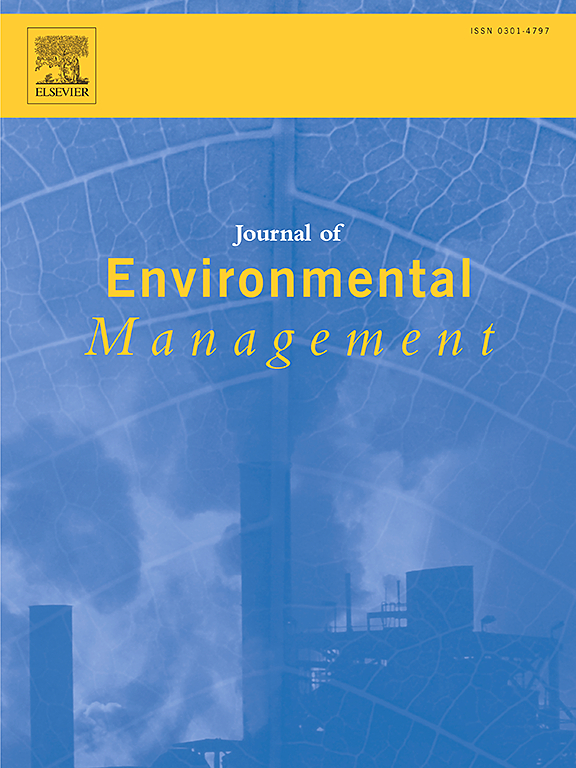Optimization of the composition of biopolymer matrices for encapsulating liquid biostimulants
IF 8.4
2区 环境科学与生态学
Q1 ENVIRONMENTAL SCIENCES
引用次数: 0
Abstract
Modern agriculture demands increasingly higher fertilizer doses to sustain crop productivity, raising concerns about nutrient loss and environmental impact. To address this challenge, this study explores the potential of biopolymer-based matrices for the controlled release of liquid fertilizers. The research focused on optimizing the matrix composition to minimize nutrient exchange and achieve a slower, sustained release of the encapsulated hydrolyzate. Using response surface methodology (RSM), the optimal concentrations of sodium alginate (4% m/m), bentonite (6% m/m), and starch (2% m/m) were determined, ensuring a gradual hydrolyzate release with an absorbance reduction from 0.148 to 0.034 over time. The optimized matrix was evaluated under simulated agricultural conditions, where swelling capacity reached 69.41% of the initial dry mass after 48 h, and the biopolymer structures exhibited 52% biodegradation within 4 weeks. Leaching experiments revealed that the highest nutrient release occurred within the first 15–60 min, followed by a linear release trend up to 168 h, ensuring sustained fertilization. In vivo tests confirmed the effectiveness of the hydrogel matrix in early-stage plant development, showing an increase in stem length by up to 29% and fresh biomass by 46% compared to the control. The encapsulated hydrolyzate enabled the application of up to a 200% fertilizer dose without phytotoxic effects, a significant improvement over direct hydrolyzate application, which previously inhibited germination at doses as low as 20%. Elemental analysis demonstrated improved nutrient retention, with potassium and sulfur concentrations following a linear uptake trend in soil. This study aims to develop a sustainable, biopolymer-based fertilization system that enhances nutrient efficiency, prevents over-fertilization, and improves crop productivity. The findings provide a foundation for precision agriculture, offering a scalable solution for optimizing nutrient release and plant growth while reducing environmental impact.

液体生物刺激剂包封用生物聚合物基质的组成优化
现代农业需要越来越多的肥料剂量来维持作物生产力,这引起了人们对养分损失和环境影响的担忧。为了解决这一挑战,本研究探索了基于生物聚合物的基质在液体肥料控制释放方面的潜力。该研究的重点是优化基质组成,以最大限度地减少营养交换,并实现包封水解产物的缓慢、持续释放。利用响应面法(RSM),确定了海藻酸钠(4% m/m)、膨润土(6% m/m)和淀粉(2% m/m)的最佳浓度,确保水解产物逐渐释放,吸光度随时间从0.148降至0.034。在模拟农业条件下对优化后的基质进行了评价,48 h后膨胀容量达到初始干质量的69.41%,4周内生物聚合物结构的生物降解率为52%。淋溶试验表明,养分释放在前15 ~ 60 min达到最高水平,随后在168 h呈线性释放趋势,保证了持续施肥。体内试验证实了水凝胶基质在植物早期发育中的有效性,与对照相比,茎长增加了29%,新鲜生物量增加了46%。包封的水解液使施用高达200%的肥料剂量而没有植物毒性作用,这比直接施用水解液有显着改善,而直接施用水解液以前在低至20%的剂量时抑制发芽。元素分析表明,土壤中钾和硫浓度呈线性吸收趋势,改善了养分保留。本研究旨在开发一种可持续的、基于生物聚合物的施肥系统,以提高养分效率,防止过度施肥,提高作物生产力。这些发现为精准农业提供了基础,为优化养分释放和植物生长提供了可扩展的解决方案,同时减少了对环境的影响。
本文章由计算机程序翻译,如有差异,请以英文原文为准。
求助全文
约1分钟内获得全文
求助全文
来源期刊

Journal of Environmental Management
环境科学-环境科学
CiteScore
13.70
自引率
5.70%
发文量
2477
审稿时长
84 days
期刊介绍:
The Journal of Environmental Management is a journal for the publication of peer reviewed, original research for all aspects of management and the managed use of the environment, both natural and man-made.Critical review articles are also welcome; submission of these is strongly encouraged.
 求助内容:
求助内容: 应助结果提醒方式:
应助结果提醒方式:


